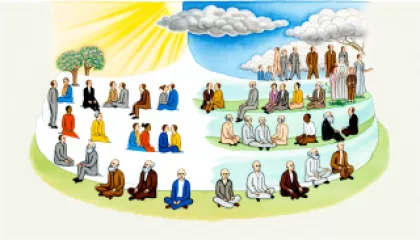Saya mengerti bahwa setiap perubahan dalam kehidupan bisa menjadi sebuah tantangan, dan kadang-kadang kita memerlukan seseorang yang bisa mendengarkan serta memahami dengan hati. Nama saya Arifin Zulkifli, dan selama lebih dari satu dekade, saya telah berkomitmen untuk menjadi teman bicara yang dapat Anda andalkan dalam mengelola transisi kehidupan serta memahami psikologi keyakinan yang Anda miliki.
Dalam perjalanan hidup, terkadang kita bertemu dengan persimpangan yang membingungkan, atau bahkan menghadapi pertanyaan besar tentang apa yang benar-benar kita percayai. Dengan menggunakan pendekatan yang penuh empati dan pengertian, saya berusaha untuk membantu Anda menemukan jawaban-jawaban tersebut, tidak hanya sebagai seorang ahli, tetapi sebagai seorang teman yang peduli.
Saya percaya bahwa setiap orang memiliki kekuatan unik dalam dirinya untuk menghadapi dan melewati masa-masa sulit. Namun, terkadang butuh sedikit bantuan untuk menemukan dan mengaktifkan kekuatan tersebut. Itulah mengapa saya di sini, untuk mendampingi Anda menelusuri setiap emosi, pikiran, dan keyakinan, baik yang baru ditemukan maupun yang lama, yang membentuk bagaimana Anda melihat dunia dan diri sendiri.
Memahami psikologi di balik keyakinan yang kita pegang erat merupakan langkah penting untuk bisa beradaptasi dan berkembang dalam setiap aspek kehidupan. Saya ingin membantu Anda menjelajahi ini dengan kedalaman dan kepekaan, menghargai setiap aspek diri Anda yang membuat Anda unik.
Dengan penekanan pada pendekatan yang mendukung dan bersifat membangun, saya berusaha untuk menciptakan ruang yang aman bagi Anda untuk mengeksplorasi, bertanya, dan tumbuh. Kepercayaan dan kejujuran merupakan fondasi dari hubungan kita, dan saya berjanji untuk menghormati setiap cerita yang Anda bagi dengan saya.
Terlepas dari apa yang mungkin Anda hadapi, ingatlah bahwa Anda tidak sendirian. Saya di sini, siap mendengarkan dengan hati terbuka dan membantu Anda menemukan jalan kembali ke ketenangan dan kebahagiaan. Mari kita bersama-sama menavigasi perjalanan ini dengan harapan, keberanian, dan pemahaman yang lebih dalam tentang diri kita dan dunia di sekitar kita.
Jika Anda merasa siap untuk memulai dialog ini, saya dengan senang hati menantikan kesempatan untuk berkenalan dengan Anda lebih lanjut dan bekerja sama dalam mencapai kesejahteraan emosional dan mental Anda.


